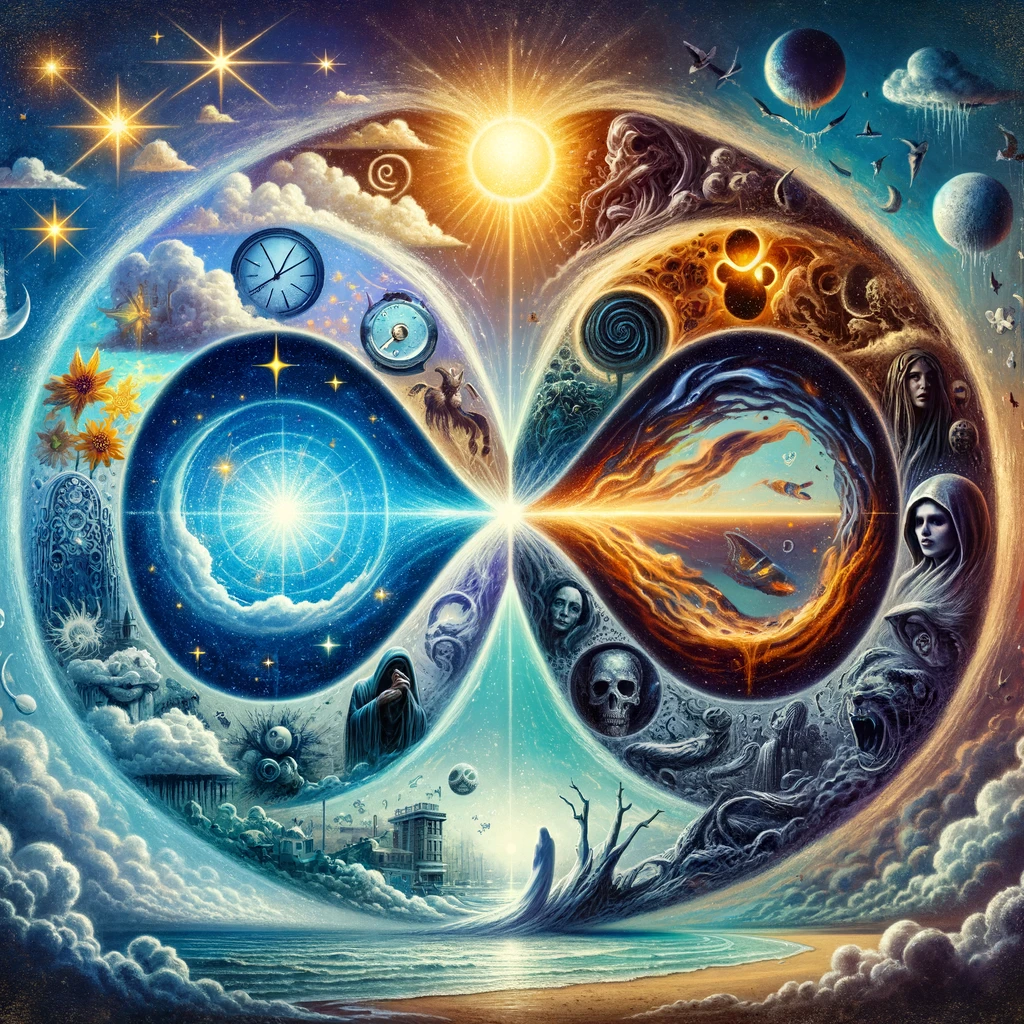You are the Soul of the Soul of the Universe. And your name is Love.
Rumi
Introduction
Transcendence represents one of the most profound principles in philosophy and spirituality, inviting us to explore the infinite potential that lies beyond the boundaries of ordinary experience. It is not merely about surpassing limits but about engaging with the infinite source from which all reality emerges and interweaves with immanence—the sacred within manifestation. This blog entry delves into transcendence as a state of pure potentiality and its role in spiritual awakening, personal growth, and the interconnectedness of the universe.
Rumi’s poetry beautifully captures the essence of transcendence:
You were born with wings, why prefer to crawl through life?
Rumi
By understanding transcendence and its interplay with immanence, we can grasp the dynamic process of becoming that bridges the finite and the infinite.
Defining Transcendence
Transcendence is the state of infinite potentiality (Zero intensity), the realm of pure possibility that precedes and exceeds manifestation. It is the unmanifest source from which all things arise, where boundaries dissolve, and the essence of the divine remains undifferentiated and infinite.
Unlike immanence, which reveals the divine in its manifest form, transcendence encompasses the beyond: the unobservable, infinite potential that underpins reality. It is not separate from existence but serves as its ground, the wellspring from which all creation flows.
Transcendence and the Process of Becoming
At its core, transcendence is not static; it is a dynamic process of becoming. From the infinite potential of transcendence, reality emerges through immanence, forming a seamless interplay:
-
Potential and Manifestation:
-
Transcendence holds the unbounded possibilities, while immanence manifests these possibilities into tangible forms and flows.
-
-
Unity and Differentiation:
-
Transcendence represents the unity of all existence in its undivided state. Immanence differentiates this unity into the diversity of life, thought, and experience.
-
-
Circularity of Existence:
-
Transcendence feeds into immanence, and immanence dissolves back into transcendence. This cyclical flow reflects the eternal nature of becoming, where potential and form continuously interact.
-
From the Finite to the Infinite
Transcendence involves a shift from the finite to the infinite, from the constraints of ego and individuality to the boundless unity of existence. This journey challenges us to:
-
Break Free from Limitations:
-
Transcendence invites us to rise above the confines of self, time, and space, connecting with the deeper essence of reality.
-
-
Engage with the Eternal Now:
-
The present moment, where past and future converge, becomes the point where transcendence meets immanence, allowing us to experience the infinite within the finite.
-
Transcendence and the Divine
The divine aspect of transcendence reflects the infinite, unmanifest reality of God or the sacred. In this understanding:
-
God as Infinite Potential:
-
Transcendence represents the divine’s infinite nature, beyond comprehension and form.
-
-
Unity of the Sacred:
-
While immanence reveals the divine within creation, transcendence reminds us of the divine’s unity and inexhaustible potential.
-
Scientific Perspectives on Transcendence
Modern science provides intriguing insights into transcendence, particularly in psychology and neuroscience:
-
Self-Transcendence Models:
-
These models describe transcendence as a state where individuals move beyond self-centeredness, experiencing unity with all existence.
-
-
Flow States and Peak Experiences:
-
Moments of intense focus and creativity—commonly referred to as flow states—are often described as transcendental, where individuals surpass their ordinary capabilities and connect with a greater reality.
-

The Infinity Loop: A Metaphor for Transcendence and Immanence
The infinity loop symbolizes the dynamic interplay between transcendence and immanence. On one side, the past resides, filled with memories that shape who we are; on the other, the future awaits, carrying aspirations and anxieties. At the intersection lies the eternal now—a luminous point where infinite potential meets tangible reality.
This convergence reflects the sacred process of becoming, where transcendence provides the unbounded source of potential, and immanence transforms it into the experiences and forms of existence. The infinity loop reminds us that past, present, and future are not isolated but interconnected, part of the continuous cycle of renewal.
Conclusion
Transcendence is the gateway to infinite potential, the process through which we rise above our limitations and connect with the boundless source of reality. Yet it is not separate from immanence but deeply intertwined with it, forming a dynamic interplay where the sacred is both unmanifest and manifest, infinite and finite.
By embracing transcendence, we engage with the eternal nature of becoming, discovering the divine not only beyond us but also within us. This journey invites us to recognize the interconnectedness of all things, fostering a holistic understanding of personal and collective growth.
The interplay between transcendence and immanence can be further clarified through the following conceptual framework.
Transcendence represents the unmanifest, the infinite potentiality, and the divine beyond form and comprehension.
Key Concepts
- Formlessness: The absence of differentiation or limitation (Taoism, Mysticism).
- Implicate Order: The enfolded, hidden unity of reality (Bohm).
- Potentiality: The infinite source from which all creation flows.
- Unity: The infinite, undivided oneness of existence beyond differentiation (Spinoza’s single substance, Brahman).
- Zero Intensity: The undifferentiated state of pure potentiality (Deleuze).
Religious Correspondences
- Al-Haqq (Sufism): The ultimate truth, infinite and beyond form or limitation.
- Brahman (Hinduism): The infinite, unmanifest ultimate reality.
- Ein Sof (Kabbalah): The infinite, unknowable divine essence.
- God Beyond (Christianity): The transcendent God who exists beyond time and space.
- Śūnyatā (Buddhism): Emptiness or void, the absence of inherent form in all phenomena.
- Tao (Taoism): The ineffable source of all things, beyond words and comprehension.
- The Holy Spirit (Christianity): The relational force uniting transcendence and immanence, connecting the infinite and finite.
If this piece moved you and you believe in the vision of HiveGeist — confronting ego, unmasking fascism, and planting seeds of collective transformation — I would be deeply grateful for your support. Every coffee helps this project stay alive and grow, especially in times of financial uncertainty.


0 Comments